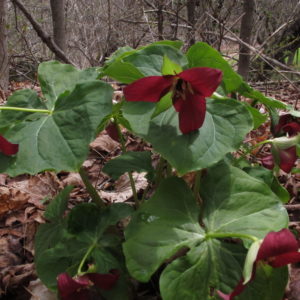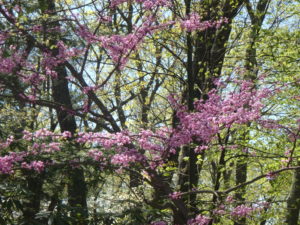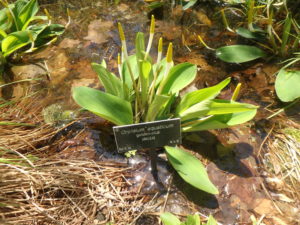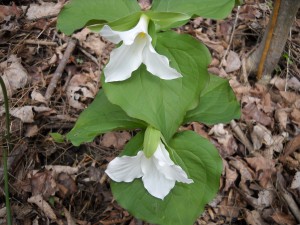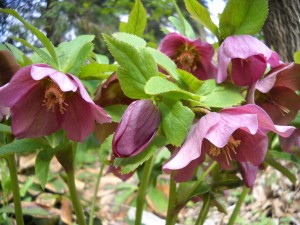Spring Wildflowers
Every spring Mother Nature gives me gifts. Or that is how it seems when she sends the blossoms of trillium, hepatica, Jack-in-the Pulpit, bloodroot, trout lily, blue cohosh, Dutchman’s breeches, squirrel corn and more to my woods and shade gardens. Of course, I have helped nature by planting wild flowers in places where I know they will be happy.
Some wild flowers I find elsewhere on my property and move to more visible locations. Others I dig from the woods of friends who are willing to share. For the rarer things, I have found garden centers and bulb companies that have sold me plants, bulbs or roots.
One of the best ways to succeed in the garden is to do your homework. Know what an individual plant needs, and what other plants grow in the same environment as the plants you wish to grow. If trillium grows in my woodlands, I can be pretty sure that Jack-in-the pulpit will do well there, too, for example, because they grow together in the wild.
In nature plants live in communities, and when designing gardens it’s important to consider that. I plan to attend a hands-on design workshop with author Claudia West in Windham, Vermont about this topic on June 9. If you are interested in attending this all-day workshop, e-mail cheath58@gmail.com. It’s a Master Gardener workshop, but open to all who are interested. Fees apply.
But what can you do if you are just starting a woodland garden, and don’t know what plants grow in areas like those you have? Visit other gardens. Walk in the woods, and observe what grows together. A maple and beech forest is quite different than one dominated by hemlocks and pines, even if a few of the others are there. Pay attention. Learn names.
I recently visited an amazing display of spring wild flowers at Garden in the Woods, in Framingham, Massachusetts. This 45 acre site is 20 miles west of Boston. The month of May is the peak bloom time, but many wildflowers continue to bloom in June, and throughout the summer. Not only that, they have an extensive nursery that sells wildflowers that I have never seen and only dreamed of growing.
My partner Cindy Heath and I walked around the property with Mark Richardson, Garden Director, and the co-author of the lovely paperback, Native Plants for New England Gardens. We were there on May 9, smack dab in the middle of Trillium Week. Garden in the Woods grows 21 of the 30 species of trillium that are native to the United States, Richardson told me. Not all were in bloom, but I saw several spectacular types.
Of the trees in bloom, two trees nearly made my heart stop with their beauty. First was the redbud (Cercis canadensis), a fine specimen of which was blooming right at the entrance. This tree, Richardson explained, exhibits cauliflory, meaning that it flowers directly on the trunk or branches of a woody plant. It has small fuschia-colored flowers that seem to pop right out of the trunk at random.
Redbud is hardy to zone 4, and is an understory tree, or one that blooms at the edges of woods. I had purchased one the week before coming to The Garden in the Woods, so seeing it there, in the woods, gave me a better idea of where to plant it in my garden.
The other tree in bloom that I saw (and bought) at Garden in the Woods is Carolina silverbells (Halesia tetraptera). Like redbud, this is a small tree for part shade and hardy to Zone 4. It has small white flowers that hang from branches before leaves appear. Mine has yet to flower or show leaves, but I am hoping to see flowers soon.
I asked Richardson to name a few of his favorite spring flowers. He explained that he liked some of the common ones, that rare flowers are not necessarily the most alluring to him. He mentioned blue cohosh (Caulophyllum giganteum), moss phlox (Phlox subulata) and pinkster bloom azalea (Rhododendron periclymenoides).
I also asked Debbi Edelstein, Director of New England Wild Flower Society, what her favorite spring flowers are. She e-mailed her response, saying, “My favorite part of spring isn’t the reappearance of particular plants, but the explosion of different shades of green and the layers of textures and colors.” I agree. I look forward each spring to the day the sugar maple on the east side of my house first displays its leaves. When the morning sun comes through the leaves I feel so lucky to be alive.
Edelstein continued, saying “That said, who doesn’t love a redbud (Cercis canadensis) in full bloom? At the Garden this time of year, I’m also drawn to the golden club (Orontium aquaticum), which is rare in New England and is weird and elemental and probably overlooked by most people; and Trillium erectum (red trillium or red Wake-robin), because it’s a deep red and is more delicate and less glamorous than, say Trillium grandiflorum.
So go out, look for wildflowers, and plant a few.
Read Henry’s blog posts at https://dailyuv.com/
Spring Flowers
I love spring. Winter is relatively austere time in the garden so I relish the bounty of spring all the more. Over the years I have tried growing most flowers that will provide color in March, April and May. Below are some of my favorites.
First to bloom are the bulb flowers that begin the spring show in March. I have thousands of snowdrops (Galanathus elwesii), squill (Scilla siberica), glory of the snow (Chionodoxa luciliae). These are followed in April by crocus, daffodils and early tulips. I cut even the smallest blossoms to bring inside and place on the kitchen counter in a vase. Almost all the bulb plants are good cut flowers. I plant bulb plants every fall, and recommend top-dressing them with organic fertilizer after they finish blooming each spring.
Then come the early perennials, starting in April and continuing on into May. One of the first, and easiest to grow, is called lungwort. The unattractive name comes from the leaves, which some unfortunate person decided looked like lungs – complete with spots on most varieties. I prefer to call them by their Latin genus, Pulmonaria, which is more melodious.
Pulmonaria will grow in sun or shade, wet or dry. They spread by root, creating large low-growing colonies. I once had a gardening client who considered them invasive, though I do not. If they overstep their welcome, I find they pull fairly easily with my favorite weeding tool, the CobraHead weeder, which gets under them easily. The small flowers come in shades of blue, pink, peach and white. They don’t do well in a vase, so I don’t pick them.
Another spring favorite of mine is the hellebore, sometimes called the Lenten Rose. Hellebores are among the earliest to send up shoots of flowers and hold those flowers for several weeks. Each flower stalk stands 12 to 15 inches tall and supports new leaves and bell-shaped flowers that are rose to purple in color, or sometimes green and white. Like the Pulmonaria, they do not last well in a vase.
Primroses bloom early, and come in a wide range of species and colors. I have at least 6 different species in bloom now. One of my favorites has no common name, only going by its scientific name, Primula kisoana. Because its species name starts with “kis”, you can call it the kissing primrose – even if no one else does (except me). It has bright magenta-colored flowers that stand just a few inches above the light-green leaves. It is not very well known at nurseries; I found mine at Cider Hill Gardens in Windsor, VT (www.ciderhillgardens.com).
An endearing quality of Primula kisoana is that it spreads by root – but never runs over another plant to establish new territory. Primroses, in general, are form clumps but spread by seed. Some, like the candelabra primrose (Primula japonica) spread very vigorously by seed if the conditions are right for it. That one stands up over two-feet tall, but blooms much later, usually in June. But P. kisoana spreads fast if the soil conditions are right. One plant can grow to cover 1 to 2 square feet in a season. They like rich, dark soil with a slightly acidic pH.
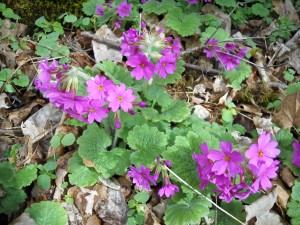 Most primroses grow well in light shade or morning sunshine and prefer moist soil. Primula kisoana, on the other hand, will grow in dry soil, too. I have observed that one of the best places to grow any primrose is under an old apple tree. The soil and light there generally is perfect for primroses.
Most primroses grow well in light shade or morning sunshine and prefer moist soil. Primula kisoana, on the other hand, will grow in dry soil, too. I have observed that one of the best places to grow any primrose is under an old apple tree. The soil and light there generally is perfect for primroses.
Although it is contrary to the law to dig up wildflowers and transplant them to your property, many good garden centers are now propagating and selling them. In nature, most spring wildflowers grow in the dappled shade of a hardwood forest. They send up flowers and leaves before the trees have leafed out, and disappear soon after the forest becomes shady. Among my favorites are the trilliums, bloodroot, and hepaticas – though there are dozens of other species.
Bloodroot are so named for the red juice that oozes from the roots if cut. I’ve read that Indians used it for dye. The leaves come up wrapped like a cigar around the flower stalk. Each simple white flower stands 6 inches tall. The blossoms open on warm, sunny days and close up at night or on chilly days. They spread by root to form nice clumps. I also have some double bloodroot – the flowers resemble small white double peonies. The flowers are probably sterile, as they keep on blooming much longer than the singles. Most flowers stop blooming once fertilized, having done their work.
I have three species of trillium: the ordinary maroon one (Trillium erectum), the white one (Trillium grandiflorum) and the yellow one (Trillium luteum). All will grow in light shade or part sun and prefer rich, dark soil. The New England Wildflower Society (www.newfs.org) sells all three – and many other fine wildflowers at their headquarters, The Garden in the Woods in Framingham, MA. I bought my yellow trillium from them. In addition to its flower, it has handsome mottled leaves.
So visit your local garden center soon to see what early spring bloomers they offer, and try something new. You’ll be glad you did.
Henry Homeyer is a gardening consultant and the author of 4 gardening books. His Web site is www.Gardening-Guy.com.



